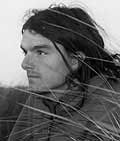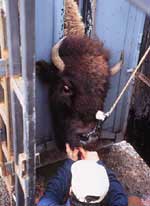
Dan Brister has been working with the Buffalo Field Campaign since December of 1997. He alternates winters on the Yellowstone boundary with falls in Missoula, Mont., where he is earning an MS in environmental studies. Dan can be contacted at dan@wildrockies.org.
Monday, 13 Mar 2000
WEST YELLOWSTONE, Mont.
Our patrols are on their way into the field along the western boundary of Yellowstone National Park. We wake each morning at 4:30 and ski into position before sunrise.
Today I’m in the office helping with communications between our patrols, monitoring law enforcement bands on the police scanner, and writing on the computer. If Montana Department of Livestock (DOL) agents come out to kill, capture, or haze buffalo, it will be my job to ensure smooth communication between patrols, alert people in the main cabin of the need for backup shifts, and make calls to the press. I am also responsible for writing the press releases which let the world know of every action taken against the buffalo. This is my third consecutive winter with the Buffalo Field Campaign, the only group working in the field, everyday, to stop the slaughter of Yellowstone’s wild buffalo. More than 300 volunteers from around the world have come to defend America’s last wild buffalo. We are currently more than 40 volunteers strong, and expect 20 new arrivals by the end of the week.

Montana ain’t land of the free for buffalo.
Photo © Buffalo Field Campaign.
We are all very thankful for the mild weather which has kept most of the buffalo safe inside the park. In the past two winters, I have watched the DOL kill 120 buffalo. The year before that, during the wicked winter of ’96-97, they killed 1,083. My sleep is still haunted with memories of buffalo being forced through narrow chutes inside the Duck Creek trap, men posed above them shouting “yee-haw!” as they whacked the buffalo, over and over, with shovels swung like golf clubs.
The Yellowstone herd is the only herd descended from continuously wild buffalo in this country. They are the direct descendants of just 23 wild bison that escaped the 19th century slaughter by finding refuge in Yellowstone’s remote Pelican Valley. Today they are at the center of a complicated management controversy. Treated as wildlife and allowed to roam free under the park’s natural regulation policy, they become “livestock” when they cross the arbitrary border into Montana and are chased through deep snow, baited with hay into traps, and corralled like cattle — or simply shot dead in the field for following their instincts.
The buffalo appear every fall, trickling from the park at Duck Creek, Cougar Creek, and the Madison River. When winter turns fierce and snow obscures the grass their bodies are built from, the buffalo pour out, migrating along the watercourses down to lower elevations outside the park. Unfortunately, this is usually a one-way migration, as most of the buffalo meet their death in Montana and never make it back to the park.

This bull is no sitting duck.
Photo © Tiffany Brown 2000, BFC.
Because of the mild winter this year, there is currently just one buffalo — a huge bull — outside the park. He’s been grazing in a meadow along the Madison River on the Gallatin National Forest since mid-January. The DOL has harassed him on five separate occasions, firing cracker barrel rounds from shotguns while chasing him with snowmobiles. Whether they intended to haze him back to the park or to their buffalo trap at Duck Creek, we don’t know. The bull has outsmarted them every time, taking refuge in trees too thick for the DOL snowmobiles to penetrate and causing them to get stuck in the deep snow, or swimming across the Madison, forcing them to drive two and a half miles back out to highway 191, over the bridge, and back in along the river’s opposite bank.
Buffalo once ranged from the eastern seaboard to California; from Great Slave Lake in northern Alberta to northern Mexico. Although no one will ever know exactly how many bison once inhabited North America, estimates range from 25 million to 70 million. William Hornaday, a naturalist who spent considerable time in the West, both before and during the most severe years of the slaughter, commented on the seemingly infinite bison population and the impossibility of estimating their quantity:
It would have been as easy to count or to estimate the number of leaves in a forest as to calculate the number of buffaloes living at any given time during the history of the species previous to 1870.
Cattle were in a large part responsible for the 19th Century buffalo slaughter, and they are behind today’s slaughter as well. In 1876, while the buffalo were being killed by the millions, General Nelson Miles predicted: “When we get rid of the Indians and buffalo, the cattle will fill this country.” He helped make his own prophesy come true.
The livestock industry is directly responsible for today’s slaughter of the Yellowstone buffalo. Lee Alley is chairman of the U.S. Animal Health Association, a government agency with close ties to the livestock industry, an agency whose actions have helped spur the Yellowstone slaughter. In 1998, he said that if it were up to him, “the herd would be depopulated, the animals destroyed, all of them.” In the past decade alone, more than 2,000 buffalo have been “destroyed,” all in the name of protecting cattle.
The radios have been quiet all morning. Our volunteers were blessed with another tranquil sunrise on the Madison River. The bull grazes — undisturbed for another day — on the meadow where he’s spent the past two months. Though I know it’s unlikely, I can’t help but hope that the remainder of the winter will continue to be this calm.

